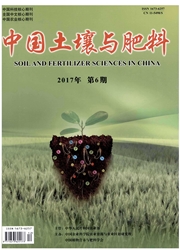

 中文摘要:
中文摘要:
为快捷、无损和精准表征冬油菜磷素营养与冠层光谱间的定量关系,该文以连续3a田间试验为基础,探究叶片磷含量的敏感波段范围及光谱变换方式,明确基于高光谱快速诊断的叶片磷含量有效波段,降低光谱分析维度,提高磷素诊断时效性。以2013-2016年田间试验为基础,测定不同生育期油菜叶片磷含量和冠层光谱反射率。此后,对原初光谱(raw hyperspectral reflectance,R)分别进行倒数之对数(inverse-log reflectance,log(1/R))、连续统去除(continuum removal,CR)和一阶微分(first derivative reflectance,FDR)光谱变换,采用Pearson相关分析确定叶片磷含量的敏感波段区域。在此基础上,利用偏最小二乘回归(partial least square,PLS)构建最优预测模型并筛选有效波段。结果表明,油菜叶片磷含量的敏感波段范围为730-1300 nm的近红外区域;基于敏感波段的FDR-PLS模型预测效果显著优于其他光谱变换方式,建模集和验证集决定系数(coefficient of determination,R2)分别为0.822和0.769,均方根误差(root mean square error,RMSE)分别为0.039%和0.048%,相对分析误差(relative percent deviation,RPD)为2.091。根据各波段变量重要性投影(variable importance in projection,VIP)值大小,确定油菜叶片磷含量有效波段分别为753、826、878、995、1 187和1 272 nm。此后,再次构建基于有效波段的油菜叶片磷含量估算模型,R2和RMSE分别为0.678和0.064%,预测精度较为理想。研究结果为无损和精确评估冬油菜磷素营养提供了新的研究思路。
 英文摘要:
英文摘要:
Leaf phosphorus content(LPC) is a critical indicator for crop growth, plant productivity and yield formation. Traditional methods of measuring LPC through plant sampling, extraction and spectrophotometric determination in the lab, not only require destructing the crop samples, but also are time-consuming and expensive. Moreover, traditional methods can't meet the demand of non-destructive and rapid monitoring of LPC in winter oilseed rape. Real-time and accurate assessment of temporal and spatial variations of crop LPC is important to help farmers improve site-specific phosphorus(P) management in sustainable agriculture. To develop a quantitative technique for evaluating LPC in winter oilseed rape using ground-based canopy reflectance spectra, 3 field experiments were carried out with different P fertilizer levels and winter oilseed rape cultivars across 3 years, and time-course measurements were taken on canopy spectral reflectance. Meanwhile, chemical assays of these winter oilseed rape samples were performed in the laboratory. In total, 92 of 138 samples were used for building spectral monitoring models of LPC and the other 46 samples were used for model validation. Then, the correlation coefficient(r) of the canopy spectral reflectance by F significant test was determined(P〈0.01), which could be used to extract sensitive wavebands. On the basis, a partial least square(PLS) regression analysis was adopted with 4 spectral transformation methods: 1) the raw hyperspectral reflectance(R), 2) logarithm of reciprocal of reflectance(log(1/R)), 3) continuum removal of reflectance data(CR) and 4) first derivative reflectance(FDR). The prediction accuracy of the optimal methods was evaluated by comparing coefficient of determination(R2), root mean square error(RMSE) and relative percent deviation(RPD) between the observed and predicted LPC values. The results indicated that LPC in winter oilseed rape increased with the increasing of P fertilization rates,
 同期刊论文项目
同期刊论文项目
 同项目期刊论文
同项目期刊论文
 期刊信息
期刊信息
